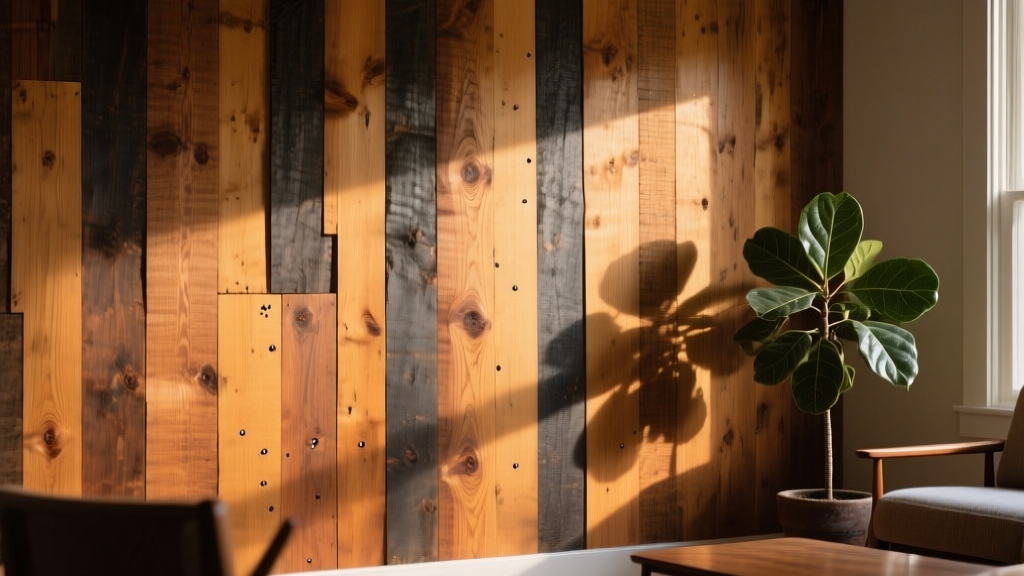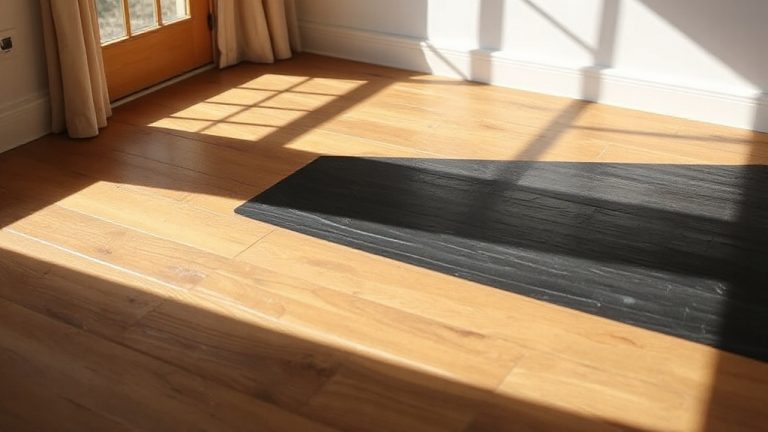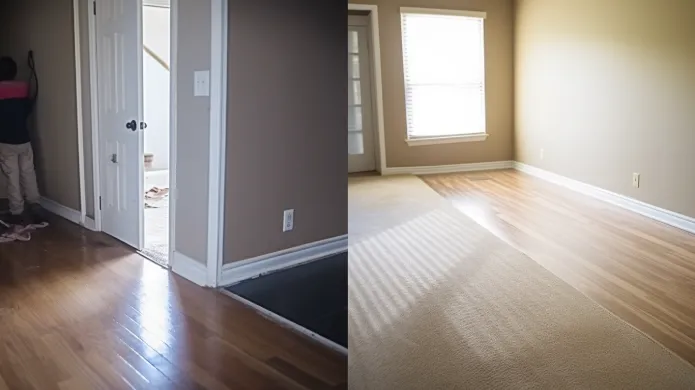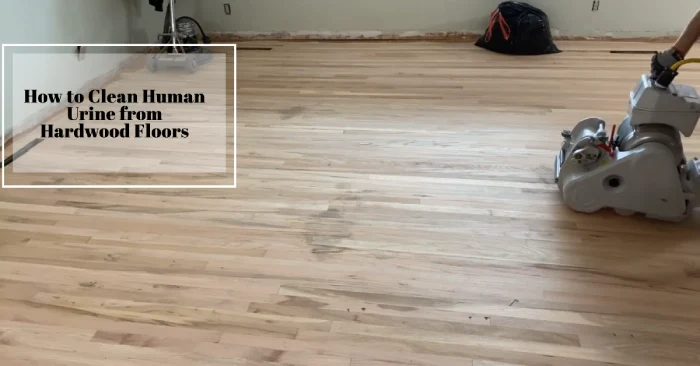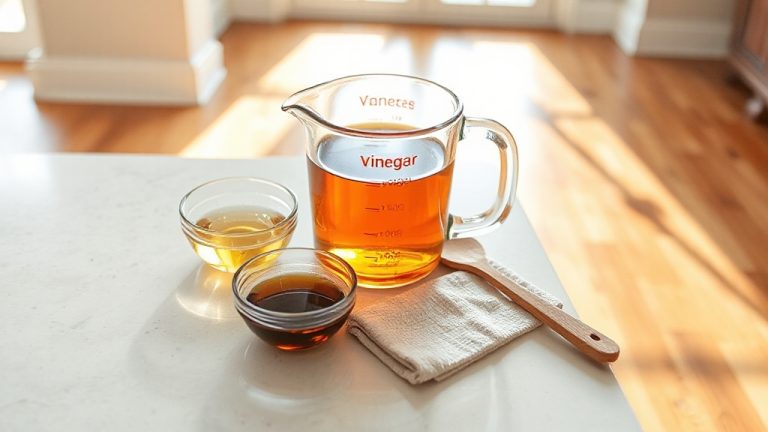Hardwood on Walls Ideas: Pairing Wood with Metal or Stone
You can transform your space by installing hardwood on walls, adding natural warmth, texture, and timeless elegance. Choose from shiplap, 3D panels, or rustic reclaimed wood to suit any style—modern, rustic, or Scandinavian.
Mix wood with metal or stone accents for stunning focal points. Installation involves careful surface prep and precise fitting for a polished look. With proper care and eco-friendly options, your hardwood walls will stay beautiful and durable.
Explore how different designs and finishes can enhance your room’s ambiance.
Key Takeaways
- Hardwood wall paneling adds warmth, texture, and natural insulation with styles like shiplap, slat walls, and board and batten.
- Creative patterns include geometric layouts, reclaimed wood textures, and multi-colored wood combinations for visual interest.
- Combine hardwood with metal or natural stone accents to create striking, durable accent walls.
- Ideal for living rooms, bathrooms, and bedrooms, hardwood walls enhance ambiance and suit various interior styles.
- Maintain hardwood walls by regular dusting, using mild cleaners, and applying occasional polishing or refinishing.
Benefits of Using Hardwood for Wall Paneling
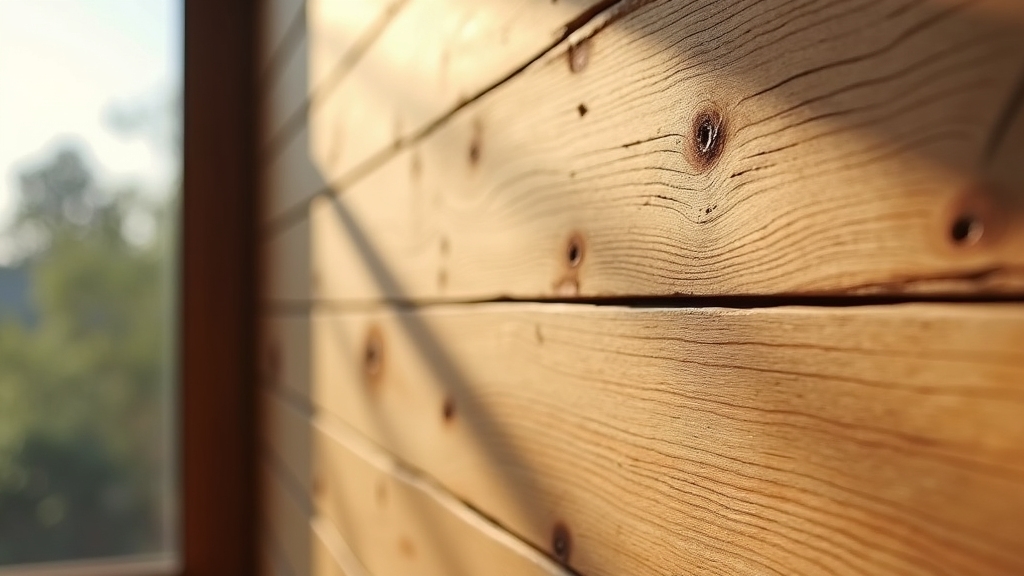
When you choose hardwood for wall paneling, you not only enhance your space’s visual appeal but also invite warmth and texture that few materials can match.
Hardwood’s unique grain patterns and rich hues add depth and sophistication, complementing any interior style—from rustic to modern. It offers versatility in design that allows customization with various profiles and textures to suit your personal taste.
Beyond aesthetics, hardwood naturally insulates, helping you maintain comfortable indoor temperatures year-round and reducing your energy costs. Its sound-absorbing qualities also create quieter, more private environments, perfect for both homes and offices.
Regular maintenance, including vacuuming and dust mopping, keeps hardwood panels looking their best. Durable and low-maintenance, hardwood resists wear, moisture, and pests, ensuring lasting beauty.
Plus, when sourced sustainably, it supports eco-friendly living by improving indoor air quality and regulating humidity. With hardwood panels, you invest in timeless elegance, comfort, and environmental responsibility all at once.
Different Types of Hardwood Panels for Walls
Hardwood wall paneling offers a variety of styles and species that can transform your space with distinctive character and texture.
Explore diverse hardwood paneling styles and species to infuse your space with unique character and texture.
You might choose shiplap for its overlapping horizontal boards, perfect for farmhouse or coastal vibes, or slat walls with vertical thin slats that create a sleek, modern look while improving acoustics. For artistic flair, 3D wood panels add sculptural depth, while tambour panels flexibly adapt to curved surfaces, blending warmth with versatility.
Board and batten panels provide clean, vertical lines suited for both traditional and contemporary rooms.
Species like American walnut bring rich dark hues, oak offers durable, warm tones, and birch delivers a sleek, light finish. Choosing the right wood species influences the overall aesthetic and ambiance of your interior space, allowing for personalization to suit your design needs.
Construction styles vary from tongue-and-groove for seamless fits to raised panels adding elegant dimension. Each option invites you to tailor your walls with precision and style.
Creative Design Patterns With Hardwood Walls
How can you transform plain walls into mesmerizing focal points? Hardwood walls offer endless creative possibilities that infuse character and style into any space. Consider these design patterns to elevate your interiors:
- Geometric Patterns: Use diagonal or grid arrangements to add depth and dynamic energy.
- Rustic Charm: Incorporate reclaimed wood for warmth and authentic texture. This sustainable option brings history and uniqueness through weathered, aged appearance.
- Scandinavian Style: Embrace light wood slats in clean, linear sequences for minimalist appeal.
- Multi-colored Walls: Combine various wood hues and grains to create striking, dimensional contrasts.
Installation Techniques for Hardwood Wall Panels
Although installing hardwood wall panels demands careful preparation and precision, mastering the process can dramatically elevate your space’s ambiance. Start by ensuring your wall is clean, flat, and stud-marked for secure anchoring.
Ensure underlying surfaces are in good condition before installation, repairing damaged plaster or loose tiles as needed to create a stable base. It is also important to address moisture issues to prevent future damage to the wood panels.
Remove outlet covers and trim for precise panel fitting, then measure and mark carefully. Cut panels using a saw or knife with masking tape along cut lines to prevent splintering.
Always dry-fit panels first, trimming for perfect alignment around outlets or uneven spots. Attach panels by drilling pilot holes and using screws into battens or studs, spacing evenly to avoid warping.
Alternatively, apply construction adhesive in a “snake-like” pattern for a clean, hidden fix, pressing panels firmly. Finish by filling holes and caulking gaps, then reinstall trims for a flawless, polished look.
Combining Hardwood With Other Materials for Accent Walls
You can elevate your accent walls by blending hardwood with metal accents, creating a striking industrial vibe through contrasting textures and finishes.
Pairing wood with natural stone brings a tactile richness, grounding your space with organic warmth and rugged elegance. These combinations let you craft walls that are both visually dynamic and deeply inviting.
Additionally, incorporating texture and warmth through wood trim introduces a tactile quality that enhances the inviting ambiance of your accent walls. Choosing materials with durability and water resistance ensures your accent walls maintain their beauty over time even in humid or high-traffic areas.
Wood and Metal Accents
Why settle for a single material when you can elevate your accent walls by combining the warmth of hardwood with the sleekness of metal? This dynamic duo adds depth and a striking contrast, turning any space into a visual masterpiece.
Remember to take precautions when sanding if refinishing wood to keep your project safe and effective. You’ll love how the textured roughness of wood plays off the smooth metal, creating a balanced yet eclectic style. Here’s how to maximize this blend:
- Use metallic strips as borders between wood panels for a structured, polished look.
- Incorporate metal into geometric patterns to boost visual impact and modern flair. Using geometric design on walls with metal accents can create a striking 3D effect that complements textured furniture.
- Choose finishes like liquid metal coatings to add luxury and contemporary edge.
- Strategically place metal accents to enhance lighting effects and focal points.
Hardwood With Stone Elements
When you combine hardwood with stone elements for accent walls, you create a striking interplay of natural textures that enriches any space. The smooth warmth of hardwood contrasts beautifully with rugged stone, adding dimension and a sophisticated focal point.
Whether in living rooms behind fireplaces or bathrooms near tubs, this blend evokes rustic charm and contemporary elegance. Select earth-toned stones to complement warm wood finishes, and use lighting to highlight their unique textures.
Here’s a quick guide to inspire your design:
| Design Application | Effect |
|---|---|
| Living Room | Warmth and structure |
| Bathroom | Spa-like ambiance |
| Bedroom | Tranquility and focus |
Tips for Maintaining Hardwood Walls
To keep your hardwood walls looking their best, establish a regular dusting routine with a soft, lint-free cloth to prevent dirt buildup and maintain their natural sheen. Regular dusting prevents surface dullness and dirt buildup, which prolongs the wall’s overall cleanliness.
Don’t forget to polish and refinish periodically to protect the wood’s finish and enhance its beauty. Use mild cleaning solutions to avoid damaging the wood surface during maintenance. Stay vigilant about scratches and moisture.
Regular Dusting Routine
Although hardwood walls are stunning additions to any space, they demand a consistent dusting routine to keep their natural beauty shining through. You should dust at least once a week, using a soft microfiber cloth or gentle duster to trap dust without scratching.
Start from the top, working your way down, paying special attention to corners, moldings, and horizontal surfaces where dust gathers fastest. Avoid rubbing; instead, gently lift dust away to protect delicate finishes. Using microfiber dust mops after dusting can enhance cleanliness and add a subtle shine.
Use microfiber tools or vacuum brushes designed for wood to avoid damage. Keep moisture minimal—never soak the wood; if needed, use a barely damp cloth and dry promptly. Because drywall dust is very fine and difficult to fully remove, water-based cleaning methods require careful application to prevent slurry issues.
Regularly check high-risk spots like radiators or window sills. Maintain stable humidity to reduce dust buildup and wood wear. Additionally, regular vacuuming with soft-bristled attachments helps remove embedded dust without scratching the surface.
Polishing and Finishing
Since hardwood walls add warmth and character to your space, maintaining their polished finish is essential for preserving that natural beauty. Begin by sanding gently with progressively finer grit, cleaning all dust before polishing. This preparation step is crucial to ensure a smooth surface for optimal polish adhesion.
Apply polish in thin, even layers using a soft cloth, always following the wood grain to avoid scratches. Work in small sections, allowing each coat to dry fully before buffing. To enhance durability, consider using products that include fire retardant properties for added protection.
Buff with a clean, dry cloth using light pressure, moving along the grain to enhance shine without swirl marks. Choose polishes designed for hardwood walls, testing first on a hidden spot to ensure color compatibility. After polishing, regularly dust with a soft cloth and avoid moisture to protect the finish.
Scratch and Moisture Care
Maintaining the polished finish on your hardwood walls goes hand in hand with protecting them from scratches and moisture damage. You’ll want to adopt a routine that addresses both issues effectively.
- Dust regularly using a lint-free cloth or soft brush vacuum attachment to prevent dirt buildup and surface dulling. Regular dusting helps maintain cleanliness and care of your hardwood walls.
- Wipe spills immediately with a dry, soft cloth to stop moisture from seeping in and causing warping or mold.
- Place felt pads under furniture and always lift items rather than dragging them to avoid scratches.
- Apply a waterproof sealant annually and ensure good room ventilation to keep humidity levels low. Avoid letting detergent or water sit or air-dry on the surface to prevent staining and promote wood health.
Sustainable Hardwood Options for Eco-Friendly Interiors
Choosing sustainable hardwood options for your interior walls not only elevates the aesthetic appeal but also supports environmental responsibility.
You can opt for recycled or reclaimed hardwood panels, which reduce landfill waste and preserve old-growth forests by repurposing wood with unique grains and rich character. Ensuring that these materials are fully dried before installation helps maintain their longevity and appearance.
Sustainably harvested wood from certified forests ensures selective logging and forest regeneration, promoting long-term ecosystem health. Look for panels treated with low-VOC finishes and natural oils to enhance durability while maintaining indoor air quality.
Additionally, consider eco-friendly solid wood fiber wallpaper as an innovative wall covering that mimics genuine wood with added environmental benefits.
Engineered wood products offer a modern, eco-friendly alternative by maximizing wood fiber use and minimizing waste. By choosing these options, you foster responsible forest management, reduce carbon emissions, and bring warmth and sustainability into your living space with every wall you clad.
Popular Hardwood Species for Wall Paneling
When you explore hardwood species for wall paneling, you’ll find a diverse palette of colors, grains, and textures that can transform your space from rustic charm to sleek modernity. Here are four popular choices to contemplate:
- American Hickory. Known for its strength and striking grain, it ranges from creamy white to deep brown, adding bold character.
- American Walnut. Offers luxurious, rich purples and browns with dramatic grain patterns, perfect for elegant interiors.
- Douglas Fir. Brings warmth with pink and gold tones, featuring rustic knots and sap marks for authentic texture.
- Maple. Provides a smooth, light surface ideal for modern designs, combining durability with subtle sophistication.
Each species uniquely influences your room’s ambiance, so pick one that reflects your style and functional needs. Maintaining these hardwood surfaces with microfiber cleaning tools helps preserve their beauty and prevent damage over time.
Frequently Asked Questions
How Do Hardwood Wall Panels Affect Indoor Humidity Levels?
Hardwood wall panels help you control indoor humidity by naturally absorbing and releasing moisture, creating a balanced environment. You’ll notice fewer humidity spikes compared to drywall, which means less risk of mold and warping.
By choosing panels with proper coatings and increasing wood surface area, you enhance this moisture regulation. Just remember, maintaining stable humidity levels protects your panels’ integrity and keeps your space comfortable and healthy.
Can Hardwood Walls Improve Room Acoustics Naturally?
Imagine your room as a concert hall where every note is clear and crisp. Yes, hardwood walls can naturally improve your room acoustics by absorbing sound waves like a sponge soaking up water.
Their fibrous structure and groove patterns reduce echoes and reverberations, especially in low to mid frequencies. You’ll notice better speech clarity and a more balanced sound environment, turning your space into an inviting, harmonious retreat.
Are Hardwood Wall Panels Suitable for Bathrooms or High-Moisture Areas?
You can use hardwood wall panels in bathrooms, but you’ll need to choose moisture-resistant types like oak veneer and apply protective sealants. Without proper treatments, wood may warp or develop mold due to humidity.
Engineered hardwood or primed MDF panels with waterproof coatings work better in steamy areas. Make sure to prep walls well and maintain sealants regularly, so your panels stay beautiful and durable despite moisture challenges.
How Long Does Hardwood Wall Paneling Typically Last Before Replacement?
Hardwood wall paneling typically lasts 25 to 35 years before you’ll need to evaluate replacement. If you maintain it well—cleaning regularly, sealing, and controlling indoor humidity—you can push that lifespan even further.
Keep in mind, moisture and wear shorten its durability, so avoid high-humidity areas unless properly treated. Choosing denser wood species and ensuring quality installation also helps your panels stay beautiful and strong for decades.
Sustainable and Long-Lasting: Eco-Friendly Hardwood Options
When you choose hardwood for your walls, you’re investing in timeless beauty and durability—qualities that matter. Did you know hardwood paneling can increase your home’s value by up to 5%? That’s a smart reason to contemplate it!
Whether you go for classic oak or sustainable bamboo, hardwood adds warmth and texture that transforms any space. With the right care and creative design, your walls won’t just look amazing. They’ll tell a story for years to come.

